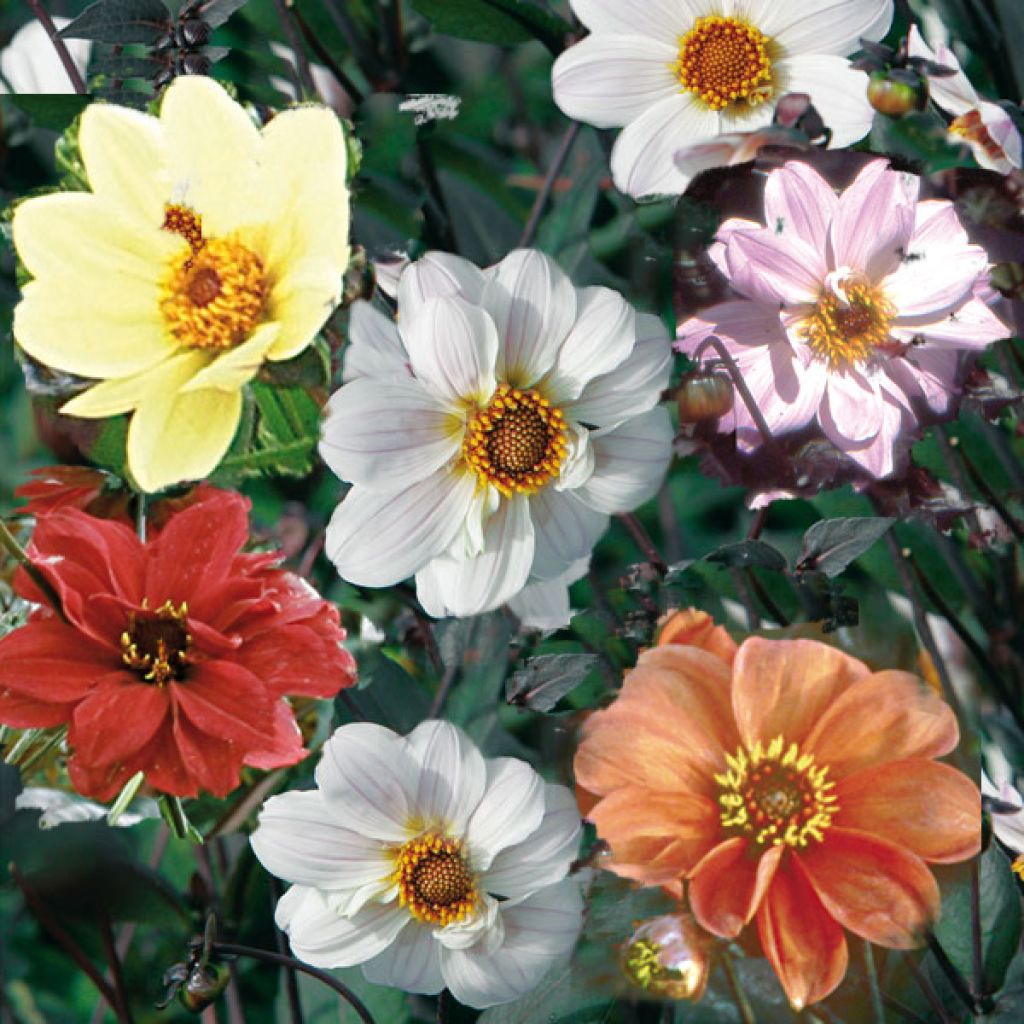

Bishop Dahlias Landscape Collection
Bishop Dahlias Landscape Collection
Dahlia Bishop (Leicester, Llandaff, Oxford, York, Dover)
A rotten rose-coloured Dahlia bishop of Landaff for which I am requesting a refund.
Catherine E., 30/05/2018
This item cannot be shipped to the selected country
Delivery charge from €5.90
More information
Schedule delivery date,
and select date in basket
This plant carries a 6 months recovery warranty
More information
We guarantee the quality of our plants for a full growing cycle, and will replace at our expense any plant that fails to recover under normal climatic and planting conditions.
From €5.90 for pickup delivery and €6.90 for home delivery
Express home delivery from €8.90.
Does this plant fit my garden?
Set up your Plantfit profile →
Collection items (5 plants)
Description
Collection of 5 assorted dahlias from the Bishop series showcasing dark-coloured foliage and stems and single to semi-double head-like flowers that are attractive to bees and other pollinators. Reaching a height of no more than 1 m (3 ft), with lighter flowers measuring 10-12 cm (4-5 in) in diameter, Bishop landscape dahlias are less susceptible to rain and generally do not require staking. They are highly floriferous plants from July to October, boasting pretty colours. They will even charm critics of dahlias who consider their large flowers too artificial for the garden. Create wildflower bouquets with the cut flowers too!
The collection consists of:
1 Bishop of Llandaff: semi-double scarlet-red flower heads with a very dark brown centre. Extremely dark foliage that is almost black-purple. Up to 1 m (3 ft) in height.
1 Bishop of Oxford: coppery orange-red flower heads, dark stems and bronze-green foliage tinged with purple to aubergine colour. Approximately 90 cm (35 in) in height.
1 Bishop of Leicester: pale lavender-pink flower heads with yellow centres and bronze foliage. Height: 60-70 cm (24-28 in).
1 Bishop of Dover: white flower heads lightly washed with lilac-pink with a golden centre, and dark bronze-brown foliage. Average height: 85 cm (34 in).
1 Bishop of York: soft golden-yellow flower heads with orange centres and chocolate-brown foliage. Approximately 90 cm (35 in) in height.
Labelled separately.
With their simple forms and stunning dark foliage, landscape dahlias are excellent garden ornaments. They pair very well with medium-sized grasses, verbenas (Verbena hastata, Verbena officinalis Bampton, etc.), and bronze fennel, for example. Landscape Dahlias have large single and naive corolla-shaped flowers, making them classics in English gardens. They beautifully enhance the layout of a dedicated flower bed or even a large glossy pot on the terrace. These plants also pair well with the grey foliage of artemisias (Powis Castle, Lambrook Silver).
Report an error about the product description
Plant habit
Flowering
Foliage
Botanical data
Dahlia Bishop (Leicester, Llandaff, Oxford, York, Dover)
Asteraceae
Cultivar or hybrid
Other Dahlias
Planting and care
Plant your dahlias during fine weather in deeply worked and enriched soil, for example with crushed horn or dried blood. Place your tuber and crumble the soil well to fill in without air pockets. Your dahlia should be covered with 6 cm (2 in) of soil. After planting, pour in 1 litre of water. Water regularly during the first 6 weeks to help with rooting. Dahlias are sensitive to cold and must be overwintered. In November, the first frosts will blacken the foliage; this is the time to uproot them. Carefully dig up the tubers, removing as much soil as possible. Let the foliage dry so that the tuber can replenish its reserves. When the foliage is dry, cut the stems 10 cm (4 in) from the tuber. Spread your bulbs in a crate on newspaper. Store in a frost-free, cool, dry and dark place.
Planting period
Intended location
Care
-
, onOrder confirmed
Reply from on Promesse de fleurs
Haven't found what you were looking for?
Hardiness is the lowest winter temperature a plant can endure without suffering serious damage or even dying. However, hardiness is affected by location (a sheltered area, such as a patio), protection (winter cover) and soil type (hardiness is improved by well-drained soil).

Photo Sharing Terms & Conditions
In order to encourage gardeners to interact and share their experiences, Promesse de fleurs offers various media enabling content to be uploaded onto its Site - in particular via the ‘Photo sharing’ module.
The User agrees to refrain from:
- Posting any content that is illegal, prejudicial, insulting, racist, inciteful to hatred, revisionist, contrary to public decency, that infringes on privacy or on the privacy rights of third parties, in particular the publicity rights of persons and goods, intellectual property rights, or the right to privacy.
- Submitting content on behalf of a third party;
- Impersonate the identity of a third party and/or publish any personal information about a third party;
In general, the User undertakes to refrain from any unethical behaviour.
All Content (in particular text, comments, files, images, photos, videos, creative works, etc.), which may be subject to property or intellectual property rights, image or other private rights, shall remain the property of the User, subject to the limited rights granted by the terms of the licence granted by Promesse de fleurs as stated below. Users are at liberty to publish or not to publish such Content on the Site, notably via the ‘Photo Sharing’ facility, and accept that this Content shall be made public and freely accessible, notably on the Internet.
Users further acknowledge, undertake to have ,and guarantee that they hold all necessary rights and permissions to publish such material on the Site, in particular with regard to the legislation in force pertaining to any privacy, property, intellectual property, image, or contractual rights, or rights of any other nature. By publishing such Content on the Site, Users acknowledge accepting full liability as publishers of the Content within the meaning of the law, and grant Promesse de fleurs, free of charge, an inclusive, worldwide licence for the said Content for the entire duration of its publication, including all reproduction, representation, up/downloading, displaying, performing, transmission, and storage rights.
Users also grant permission for their name to be linked to the Content and accept that this link may not always be made available.
By engaging in posting material, Users consent to their Content becoming automatically accessible on the Internet, in particular on other sites and/or blogs and/or web pages of the Promesse de fleurs site, including in particular social pages and the Promesse de fleurs catalogue.
Users may secure the removal of entrusted content free of charge by issuing a simple request via our contact form.
The flowering period indicated on our website applies to countries and regions located in USDA zone 8 (France, the United Kingdom, Ireland, the Netherlands, etc.)
It will vary according to where you live:
- In zones 9 to 10 (Italy, Spain, Greece, etc.), flowering will occur about 2 to 4 weeks earlier.
- In zones 6 to 7 (Germany, Poland, Slovenia, and lower mountainous regions), flowering will be delayed by 2 to 3 weeks.
- In zone 5 (Central Europe, Scandinavia), blooming will be delayed by 3 to 5 weeks.
In temperate climates, pruning of spring-flowering shrubs (forsythia, spireas, etc.) should be done just after flowering.
Pruning of summer-flowering shrubs (Indian Lilac, Perovskia, etc.) can be done in winter or spring.
In cold regions as well as with frost-sensitive plants, avoid pruning too early when severe frosts may still occur.
The planting period indicated on our website applies to countries and regions located in USDA zone 8 (France, United Kingdom, Ireland, Netherlands).
It will vary according to where you live:
- In Mediterranean zones (Marseille, Madrid, Milan, etc.), autumn and winter are the best planting periods.
- In continental zones (Strasbourg, Munich, Vienna, etc.), delay planting by 2 to 3 weeks in spring and bring it forward by 2 to 4 weeks in autumn.
- In mountainous regions (the Alps, Pyrenees, Carpathians, etc.), it is best to plant in late spring (May-June) or late summer (August-September).
The harvesting period indicated on our website applies to countries and regions in USDA zone 8 (France, England, Ireland, the Netherlands).
In colder areas (Scandinavia, Poland, Austria...) fruit and vegetable harvests are likely to be delayed by 3-4 weeks.
In warmer areas (Italy, Spain, Greece, etc.), harvesting will probably take place earlier, depending on weather conditions.
The sowing periods indicated on our website apply to countries and regions within USDA Zone 8 (France, UK, Ireland, Netherlands).
In colder areas (Scandinavia, Poland, Austria...), delay any outdoor sowing by 3-4 weeks, or sow under glass.
In warmer climes (Italy, Spain, Greece, etc.), bring outdoor sowing forward by a few weeks.

















































